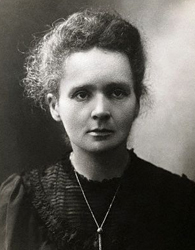The first woman in France to receive a doctorate degree, scientist Marie Curie is remembered for her discoveries in radioactivity and radioactive elements. Her work won her two Nobel prizes in physics and chemistry, but unfortunately also led to her death.
Marie Curie’s Early Days
Marie Skłodowska was born in Warsaw, Poland on November 7, 1867, the youngest of five children. Skłodowska’s parents were poor schoolteachers; her mother and eldest sister both died when she was young. Skłodowska graduated from high school at the age of 15, but the oppressive policies of the Russian government prevented her from attending public university. Skłodowska worked as a governess to earn money to support her older sister’s studies in Paris. By 1891, Skłodowska had saved enough money to join her sister in Paris, where she began studying math, physics and chemistry at the University of Paris. She earned her undergraduate degree in 1893 and her master’s in 1894; in 1903, she became the first woman in France to receive a doctorate degree.
While studying at the University of Paris, Skłodowska married French professor Pierre Curie in 1895. The Curies bonded over a shared interest in magnetism, which they had both been researching. She developed an interest in radiation, which had recently been discovered in pitchblende, the ore containing uranium. Curie began studying pitchblende and exploring the sources of radioactivity in the ore.
Sources in this Story
- The Great Idea Finder: Marie Curie
- FindingDulcinea: On this Day: Marie and Pierre Curie Discover Radium
- Nobelprize.org: Marie Curie
- Chemical Achievers: Marie Curie
- Time: Death of Mme Curie
- IMDb: Madame Curie (1943)
Curie’s Notable Accomplishments
Marie Curie and her husband worked closely together in their laboratory. They believed that uranium was not the only element in the ore that emitted radiation. They used chemical processes to analyze pitchblende for other substances that they dubbed radioactive. In 1898, the Curies announced the discovery of a new element, which they named polonium in tribute to Curie’s native Poland. That same year, the couple identified another undiscovered element, which they named radium. The existence of radium was discovered after the Curies chemically processed a ton of pitchblende in their shed-turned-laboratory. In 1903, the Curies were jointly awarded the Nobel Prize for Physics for their discoveries in the area of radiation and radioactivity, making Marie Curie the first woman to win the prize.
In 1906, Pierre Curie died in Paris when he was run over by a horse-drawn cart in the street. The University of Paris gave Curie her husband’s position as professor of physics; she was the first woman to hold this position. With the financial help of her father-in-law, Curie was able to continue her experiments with radium. In 1911, Curie was awarded the Nobel Prize in Chemistry for discovering and isolating radium. Curie was the first person to win two Nobel Prizes; she is still the only person to have won in two different scientific fields. Curie became the head of the Paris Institute of Radium in 1914. During World War I, Curie promoted radiology as a medical tool for treating wounded soldiers. In 1921, U.S. president Warren G. Harding awarded Curie with one gram of radium in recognition of her scientific contributions.
The Woman and her Work
- “Madame Curie: A Biography” by Ève Curie
- “Marie Curie: A Life” by Susan Quinn
- “Obsessive Genius: The Inner World of Marie Curie” by Barbara Goldsmith
- “Radiation And Modern Life: Fulfilling Marie Curie’s Dream” by Alan E. Waltar
- “Madame Curie” (DVD)
The Rest of the Story
Marie Curie died of anemia on July 4, 1934. Her illness has since been attributed to her exposure to radioactive materials, which Curie regularly handled without the use of protective equipment. At the time of her experiments, the harmful effects of radiation were not known.
Marie Curie’s face was printed on the 500-franc note before it was replaced by the euro. A 1943 film, “Madame Curie,” was produced about her life and accomplishments, based on a biography written by her daughter, Ève Curie. In 1935, her other daughter, Irene Joliot-Curie, won the Nobel Prize for Chemistry for her experiments with aluminum and radiation.
This article was originally written by Caleb March; it was updated November 3, 2017.











